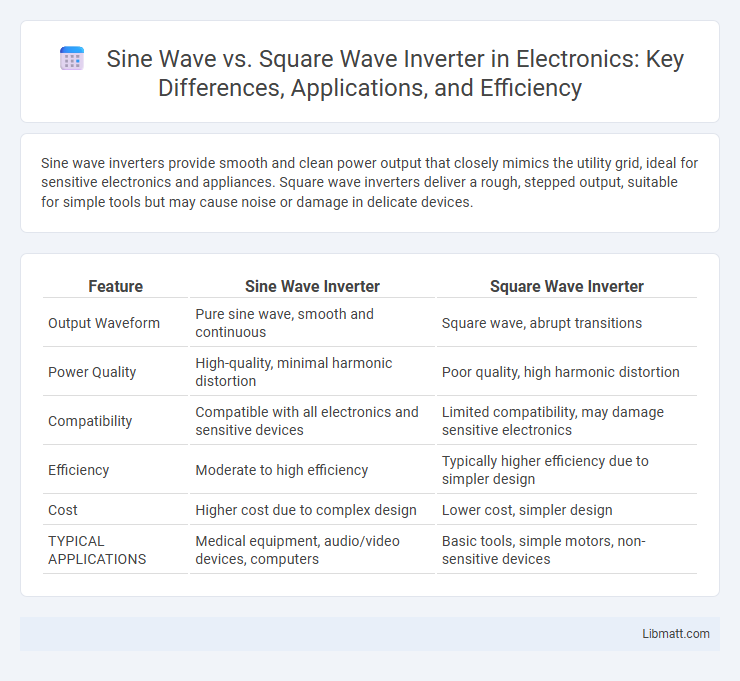Sine wave inverters provide smooth and clean power output that closely mimics the utility grid, ideal for sensitive electronics and appliances. Square wave inverters deliver a rough, stepped output, suitable for simple tools but may cause noise or damage in delicate devices.
Table of Comparison
| Feature | Sine Wave Inverter | Square Wave Inverter |
|---|---|---|
| Output Waveform | Pure sine wave, smooth and continuous | Square wave, abrupt transitions |
| Power Quality | High-quality, minimal harmonic distortion | Poor quality, high harmonic distortion |
| Compatibility | Compatible with all electronics and sensitive devices | Limited compatibility, may damage sensitive electronics |
| Efficiency | Moderate to high efficiency | Typically higher efficiency due to simpler design |
| Cost | Higher cost due to complex design | Lower cost, simpler design |
| TYPICAL APPLICATIONS | Medical equipment, audio/video devices, computers | Basic tools, simple motors, non-sensitive devices |
Introduction to Inverter Waveforms
Inverter waveforms primarily include sine wave and square wave types, each influencing device performance and compatibility differently. Sine wave inverters produce smooth, continuous waveforms closely mimicking utility power, ideal for sensitive electronics and appliances. Square wave inverters generate abrupt transitions with high harmonic distortion, potentially causing noise and reduced efficiency in inductive loads.
What is a Sine Wave Inverter?
A sine wave inverter converts direct current (DC) into alternating current (AC) that closely mimics the smooth, periodic oscillation of a pure sine wave, ensuring compatibility with sensitive electronic devices. This type of inverter produces clean and stable power, reducing the risk of electrical noise, overheating, and damage to appliances like medical equipment, audio devices, and sophisticated motors. Compared to square wave inverters, sine wave inverters deliver higher efficiency and are essential for home, industrial, and renewable energy systems demanding reliable and high-quality power supply.
What is a Square Wave Inverter?
A square wave inverter converts direct current (DC) into a square-shaped alternating current (AC) waveform, producing abrupt voltage transitions between positive and negative peaks. This type of inverter is simpler and more cost-effective but can cause noise and inefficiency in sensitive electronic devices due to its non-sinusoidal output. Square wave inverters are suitable for basic applications like powering simple motors and incandescent lighting, where precise waveform quality is less critical.
Key Differences Between Sine Wave and Square Wave Inverters
Sine wave inverters produce smooth, continuous waveforms that closely mimic the natural electricity supplied by utility companies, making them ideal for sensitive electronics and appliances. Square wave inverters generate a more abrupt, stepped waveform that is simpler and less expensive but can cause noise, reduced efficiency, and potential damage to delicate devices. Your choice between sine wave and square wave inverters should consider the compatibility of your equipment and the quality of power required for optimal performance.
Efficiency Comparison: Sine vs Square Wave Inverters
Pure sine wave inverters deliver higher efficiency by producing smooth, consistent AC output that closely matches utility power, reducing energy loss in sensitive equipment. Square wave inverters typically exhibit lower efficiency due to their abrupt voltage transitions, which cause increased harmonic distortion and heat dissipation. Efficiency rates for sine wave inverters can be as high as 90-95%, whereas square wave inverters often operate below 80%, impacting overall system performance and power consumption.
Impact on Appliances and Devices
Pure sine wave inverters produce smooth, consistent electrical output that closely mimics utility power, ensuring optimal performance and longevity of sensitive appliances like medical equipment, audio systems, and variable-speed motors. Square wave inverters generate a rougher, stepped waveform that can cause overheating, noise, and reduced efficiency in devices with inductive loads or electronics requiring stable voltage. Choosing a sine wave inverter protects your appliances from potential damage and operational issues, making it the preferred option for reliable and safe power conversion.
Power Quality and Harmonic Distortion
Pure sine wave inverters deliver superior power quality by producing smooth, continuous waveforms that closely mimic utility grid electricity, minimizing harmonic distortion and ensuring the safe operation of sensitive electronic devices. Square wave inverters generate abrupt, non-sinusoidal waveforms with high harmonic distortion, which can cause overheating, noise, and reduced efficiency in many appliances. Your choice of inverter affects overall system performance, particularly in applications requiring clean power and reduced electromagnetic interference.
Cost and Affordability Factors
Square wave inverters are typically more affordable due to their simpler design and lower manufacturing costs, making them suitable for budget-conscious users. Sine wave inverters, while more expensive, provide cleaner and more reliable power output suitable for sensitive electronics, justifying the higher investment. Your choice depends on the balance between initial cost and the need for high-quality power delivery.
Applications of Sine Wave and Square Wave Inverters
Sine wave inverters are ideal for sensitive electronics, medical equipment, and audio systems due to their smooth, clean power output that mimics utility grid electricity. Square wave inverters are commonly used in simple tools, basic lighting, and devices with motors that can tolerate lower-quality power. Your choice depends on the compatibility and performance requirements of the equipment you need to power.
Choosing the Right Inverter for Your Needs
Sine wave inverters produce smooth, pure waveforms ideal for sensitive electronics, whereas square wave inverters generate simpler waveforms suited for basic devices. Your choice depends on the type of appliances you intend to power and the need for efficiency or cost-effectiveness. Selecting the right inverter ensures optimal performance, longevity, and safety for your electrical systems.
Sine wave vs Square wave inverter Infographic

 libmatt.com
libmatt.com